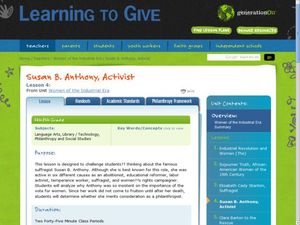Curated OER
African American Life in the Nineteenth Century
Students read about the life and work of John and Mary Jones. Using primary source documents, they draw conclusions about their role in the abolistionist movement. They also examine artifacts from their lives and analyze their portrait...
Curated OER
Freedom and Dignity Project
Eleventh graders explore slavery and the civil war. In groups, 11th graders discuss and slavery and identify reasons for its beginning. In groups, they role-play a character for a talk show. Students determine what slavery was like in...
Curated OER
John Jones and the Fight to Repeal the Black Laws
Students examine the role of John Jones and his fight to repeal the Black Laws of Illinois. Using the text of the law, they explore his reasoning for repealing the laws and the arguments he used to support his beliefs. They draw their...
Curated OER
The Underground Railroad Before and After the Fugitive Slave Law
Students consider the impact of the Fugitive Slave Law on the activity of the Underground Railroad. In this slavery lesson, students examine primary documents that describe the role of the Underground Railroad during the fight for...
Middle Tennessee State University
John Brown: Hero or Villain?
"Love it or leave it." "You're either for us or against us." Rhetoric and it's polarizing effects are the focus of a lesson that uses John Brown's attack on Harper's Ferry as an exemplar. Groups examine primary source documents,...
Anti-Defamation League
Harriet Tubman on the $20 Bill: The Power of Symbols
How important are symbols and symbolic gestures in society? Middle schoolers have an opportunity to analyze the importance of symbols on American currency with a lesson plan that investigates the controversies surrounding redesigning the...
City University of New York
The Split Over Suffrage
Compare and contrast Frederick Douglass's and the National Women's Suffrage Association's stances on equal rights and suffrage with a series of documents and worksheets. Learners work together or independently to complete the packet, and...
Curated OER
Abolishing Slavery
Students explain the goals and methods of the abolitionist movement.
They identify key leaders in the movement. This lesson has adaptations for elementary through high school. Links are provided for resource readings.
National First Ladies' Library
The Debate on Slavery
Young historians research the debate over slavery; some students take the pro-slavery side and others the anti-slavery side. They take the role of a character such as a plantation owner, a legislator, a free Black, a slave, or a northern...
Curated OER
Susan B. Anthony, Activist
Students examine Susan B. Anthony's life and causes she worked for. In this Susan B. Anthony lesson, students work in groups to research the activist roles of Susan B. Anthony and decide if she was a philanthropist. Students look into...
Curated OER
United States Colored Troops
Students explore the role that African American soldiers had in the Civil War and the impact they had on the US Civil Rights movement after the war. They complete a timeline, read an excerpt and analyze a primary image.
Curated OER
Gold Rush Abolitionists: How different was the role of Spanish-speaking blacks under Mexican rule from the role of English-speaking blacks under U.S. rule?
Students determine how Spanish-speaking blacks and English speaking blacks were treated differently. For this emancipation lesson, students compare the Mexican and American rules regarding slavery.
Curated OER
Perspective on the Slave Narrative
Students work with the slave narrative as a resource for historical study and evaluate it as a work of literature; students then examine the narrative in the context of political controversy as an argument for abolition.
Curated OER
I Get By With a Little Help From My Friends
Eleventh graders "walk a mile" in a person's shoes who had a role in the Underground Railroad and examine the risks and complications of the Underground Railroad.
Curated OER
How Women Won the Right to Vote
Students consider how women gained the right to vote in America. In this suffrage lesson, students investigate major events of the suffrage movement and conduct research. Students also role play petitioning to President Wilson to get the...
Curated OER
The Patchwork Path
Fourth graders investigate slavery by reading a book with their classmates. In this abolitionist movement lesson, 4th graders read the story The Patchwork Path, and discuss the creation of the Underground Railroad. Students create...
Curated OER
Reforms of the Mid-1800's
Seventh graders complete a unit of lessons on the reform movements of the mid-1800's in the U.S. They participate in an Internet scavenger hunt, analyze primary source documents, and develop and perform a simulation of a mid-19th century...
Curated OER
Abolition of Slavery
Young scholars examine the Triangle Trade Route. In this slave trade lesson, students investigate the profits brought by the goods and people traded. Young scholars also participate in a classroom activity that requires them to replicate...
Curated OER
Underground Railroad Activity
Eighth graders practice their interviewing skills as they learn about the Underground Railroad. In this slavery activity, 8th graders discuss the existence and operation of the railroad. Students then interview one another in the...
Curated OER
Examining the Ties Between Abolitionism and the Women's Rights Movement
Students examine the historical link between the abolition and women's movements. After a brief introduction and mini-lecture, students work in pairs or small groups to complete a web quest to answer instructor provided questions...
Curated OER
Reconstruction
Students investigate the historical period of the Reconstruction and the events that surrounded the abolitionist movement. Students use guided questions to conduct research. Then they complete a venn diagram in order to compare two...
Curated OER
Lesson Plan: The 1856 Election
High schoolers identify the key issue in the election of 1856, they also identify some of the key people invovled in the election. Students discuss the role of propaganda in politics. Also, high schoolers discuss the significance of the...
Curated OER
John Brown, Then and Now
Eleventh graders study one of the selected images of John Brown and read an excerpt online that describes his role in the Civil War. They identify significant information about John Brown. They think about how this applies to current...
Curated OER
SLAVERY IN ARKANSAS, THE LIFE OF A SLAVE
Learners participate in a variety of activities to demonstrate an understanding of mid 1800 role of slaves. Vocabulary, writing and math are integrated into the lesson.

























